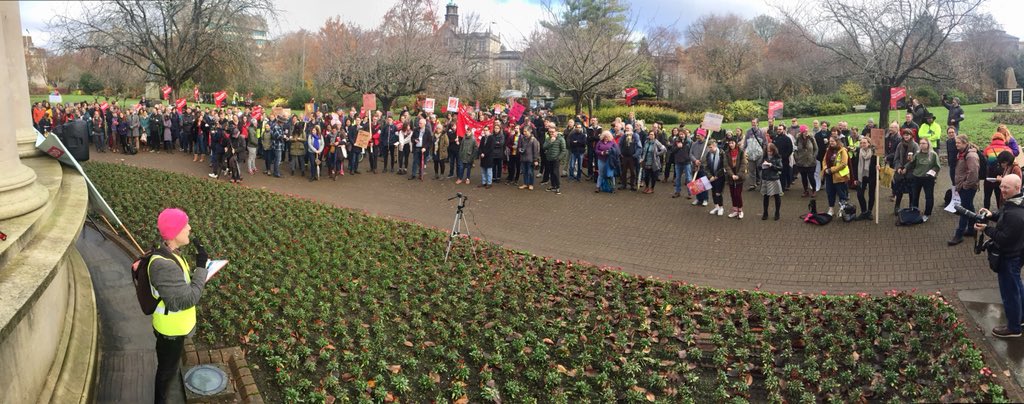The pattern became obvious, soon enough. In the past, students asked for the extenuating circumstances form for a variety of reasons: an illness during the exam period, a death in the family, from time to time a personal crisis or a bout of poor mental health. But now, there are only two reasons: anxiety and depression, anxiety and depression, anxiety and depression.
In Mark Fisher’s words:
“Instead of treating it as incumbent on individuals to resolve their own psychological distress, instead, that is, of accepting the vast privatization of stress that has taken place over the last thirty years, we need to ask: how has it become acceptable that so many people, and especially so many young people, are ill?” (Capitalist Realism, p 23)
The UCU union has been on strike in 60 universities across the UK since November 25th. “A lecturers’ strike,” says the press, “over pensions.” A convenient, partial, truth. The UCU is a trade union for university workers, not just lecturers, and this strike is about much more than pensions. There were two ballots, one on changes to the USS pension fund – this was the cause of the spring 2018 strike – and one about pay, inequality, workloads, and precarity. UCU members voted decisively for strike action, 79% in the first ballot and 74% in the second.
“Precarity” has become a familiar term in the academic world. Around a third of academic workers in the UK, researchers as well as teachers, are on precarious contracts, namely short-term contracts lasting six months or a year. Your university might bless you with another term’s work after the end of your contract – or it might not. There is no certainty or stability in this precarious world. Precarious academic workers have to spend a great deal of their time applying for the next job, the next grant, moving from university to university hoping to reach eth promised land: a permanent job.
Precarious workers are easier to exploit. Since 2009, academic workers’ pay has fallen by 20.9%, taking inflation into account. (That’s the union’s figure. The UCEA, the body representing university employers, has a much more generous estimate: a fall of only 17%.) During the same period, workloads have increased enormously. Spending nights and weekends planning lectures and seminars, or marking essays and exam scripts, is a normal experience. No-one is surprised to hear that all their colleagues are at 120% of their official workloads. How can precarious workers refuse?
And of course, precarity weighs most heavily on the shoulders of the least privileged. Without an affluent family to support them, without contacts in the academic world, precarity can force many female, working-class, and BAME academic workers out of the university entirely. The gender and racial pay gaps attest to working conditions for those who remain. There is a 16% pay gap between men and women (21.6% in Cardiff University – one of the worst in the UK), and a 9% gap between white and BAME academic workers (14% in the case of black academics). These gaps reflect the fact that female and BAME academic workers are more likely to be on precarious contracts, and less likely to have high-ranking jobs within the university.
This deterioration in working conditions is of no interest to university management. As Cardiff University’s website says, “There are multiple pressures on costs, the most significant being the cost of employment.” Certainly, the University had an operating deficit of £22.7 million in 2018. But there might be a connection between this challenging situation and the decision taken by the Vice-Chancellor, Prof. Colin Riordan (who earns £256 798 a year, excluding other allowances), to launch “Transforming Cardiff” – an enormous building and re-organization programme, with the aim of maintaining Cardiff’s place in the top 100 universities in the world. The University borrowed and spent £50.3 million to this end in that challenging year, 2018. There are ample opportunities for investors and developers to profit from Transforming Cardiff, by lending to the University or building new student accommodation. Cardiff Council and the Welsh Government are happy to cooperate. You can see the results all over Cardiff, as high-priced flats for hypothetical students take over entire streets, contributing to the process of gentrification which is pushing working class and BAME residents out of the city.
In the meantime, the “pressures on costs,” also known as university workers and students, do their best to survive. They don’t always succeed. The current mental health crisis is the direct result of precarity and impossible workloads. 13 students have died from suicide at Bristol University in the last three years. In Cardiff, the accounting lecturer Malcolm Anderson died in February 2018. He had been working between 70 and 80 hours a week. He had been asked to mark 418 exam scripts in 20 days.
The University’s response was to put locks on the windows.
Forget pensions. This is why university workers are on strike.
Even in this crisis, there is hope. UCU membership is increasing. On the picket lines and in the teach-outs, we’ve caught glimpses of the university we’d like to see: an open and democratic space, where academics and students can work together. In her brilliant essay “A World of Gap Years and Gilt Frames,” Polly Manning argues that Wales should not try to replicate the hierarchical, privileged structures of universities like Oxford and Cambridge.
“Devolved higher education in Wales should present us with an opportunity to forgo the elitism and snobbery which hounds the intelligentsia of the British state, an opportunity to start afresh and construct our own measures of what constitutes a ‘great’ education. Our universities should be fully in a position to thrive on the basis of accessibility, garnering the experiences of black and minority ethnic students, poor students, disabled and queer students, in creating our own definition of prestige.” (Planet 228, p 35).
The current state of academia has to change. This is the gap in which something better can appear.

